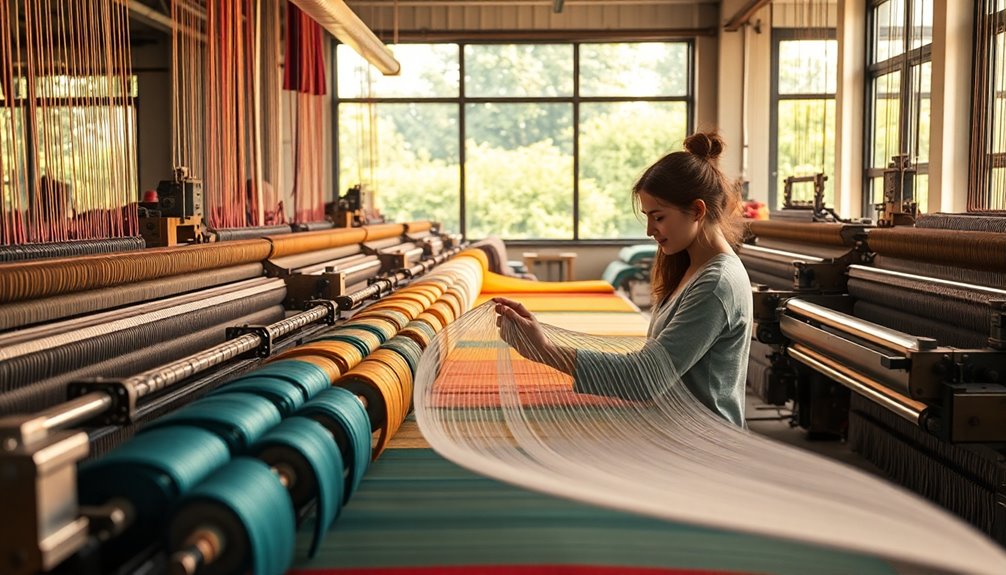Proto textiles are revolutionizing the fabric industry by marrying traditional practices with cutting-edge technology. You'll see innovations like smart textiles, 3D printing, and nanotechnology enhancing functionality and sustainability. As brands increasingly adopt recycled and organic materials, they're reducing environmental impacts. With digital transformation driving efficiency through AI and blockchain, the industry is reshaping its future. If you're curious about how these changes could influence market dynamics, you'll uncover even more fascinating insights.
Key Takeaways
- Proto-textile practices are integrating sustainable materials, reducing reliance on non-renewable resources and minimizing environmental impact.
- Innovations in smart textiles enhance functionality, enabling fabrics to respond to environmental stimuli and improve user experience.
- The use of blockchain technology in supply chains promotes transparency and ethical production practices within the fabric industry.
- Automation and digital printing technologies streamline production processes, allowing for rapid adaptation to market demands and reducing waste.
- The rise of 3D printing allows for complex fabric designs, pushing the boundaries of traditional textile manufacturing capabilities.
The Legacy of Proto-Industrialization in Textiles
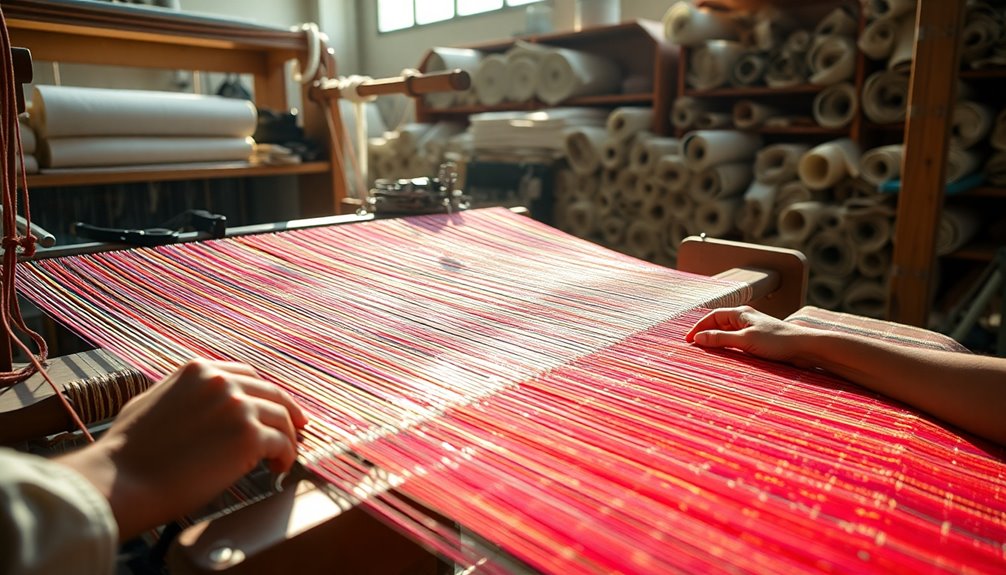
While many people mightn't realize it, proto-industrialization laid the groundwork for the modern textile industry that we see today. This early phase concentrated production in rural areas, utilizing the putting-out system to engage workers in textile manufacturing.
By integrating these workers into a cash-based economy, it fostered an entrepreneurial culture that remains essential. The accumulation of profits allowed merchants to invest in new technologies, paving the way for innovations like the spinning jenny. Additionally, proto-industrialization strengthened marketing networks and weakened urban guilds, promoting economic diversification and shaping the landscape of textile production. Its legacy is evident today, as the emphasis on efficiency and market adaptation continues to influence how textiles are produced and marketed across the globe.
Technological Innovations Shaping the Future
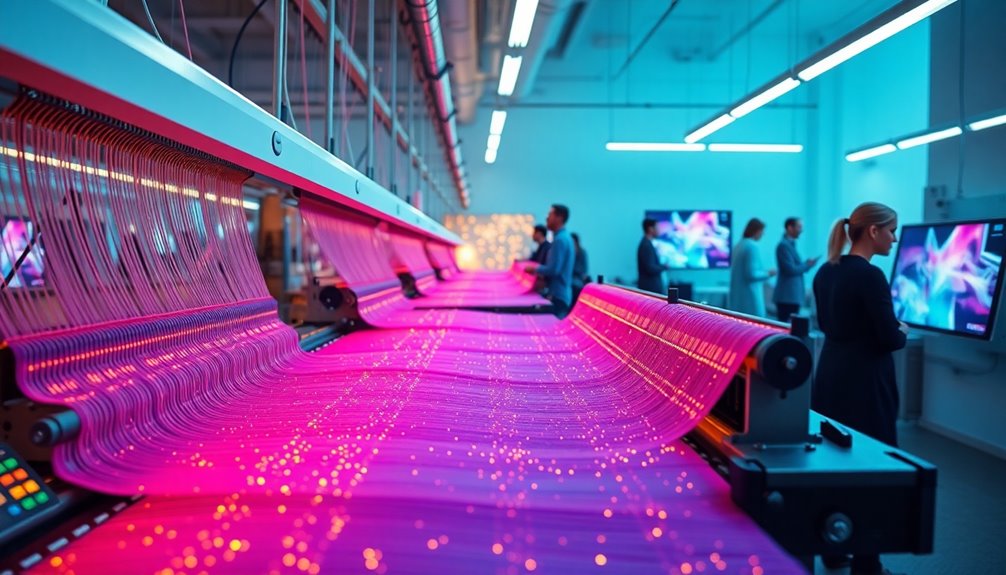
The legacy of proto-industrialization has set the stage for groundbreaking advancements in the textile industry. You're witnessing the rise of smart textiles, integrating electronics for enhanced functionality and interactivity. With 3D printing, you can now create complex designs previously deemed impossible. Nanotechnology enhances fabric properties, making textiles self-cleaning and UV-resistant. Sustainable practices introduced by biotechnology also offer biodegradable options, while digital printing provides customization and on-demand production, minimizing waste. Advances in material science like graphene and bamboo fibers provide strength, comfort, and eco-friendliness. Meanwhile, wearable technology and responsive fabrics are revolutionizing user experience through interactivity. As microfactories and waterless printing emerge, sustainable manufacturing becomes more attainable, paving the way for a more innovative, efficient, and environmentally friendly fabric industry.
The Shift to Sustainable Practices
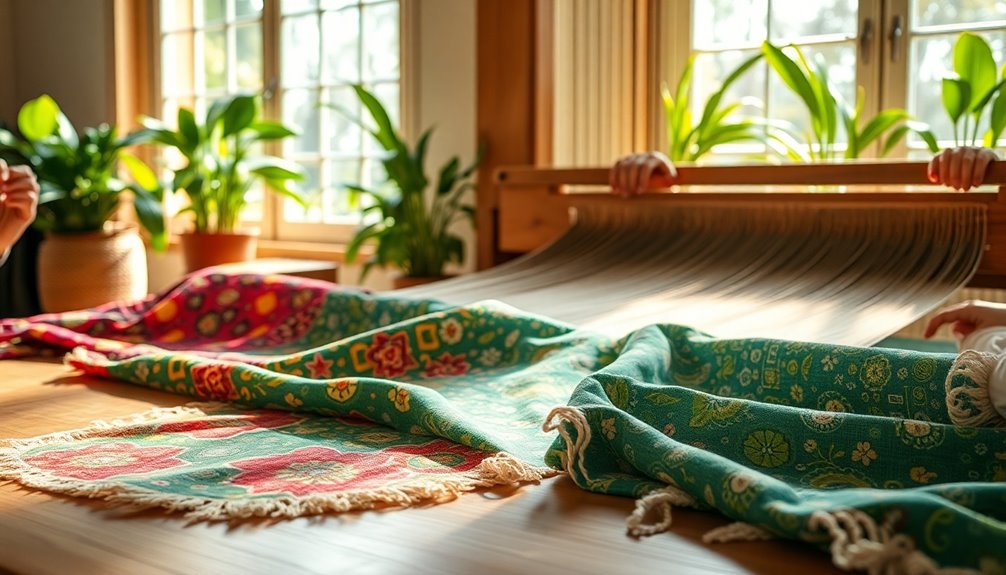
As consumers become more environmentally conscious, the textile industry is responding by shifting towards sustainable practices that minimize ecological impact. You'll find brands embracing recycled fibers like REPREVE and ECONYL, which cut down on plastic waste and emissions. Organic materials, such as cotton and hemp, are now popular choices due to their lower environmental footprint. Additionally, the focus on reducing dependence on non-renewable resources drives exploration of biobased materials. Waterless dyeing technologies greatly reduce water usage, while energy-efficient machinery supports renewable energy initiatives. Furthermore, real-time data analytics help companies optimize resource consumption.
Digital Transformation in Textile Production
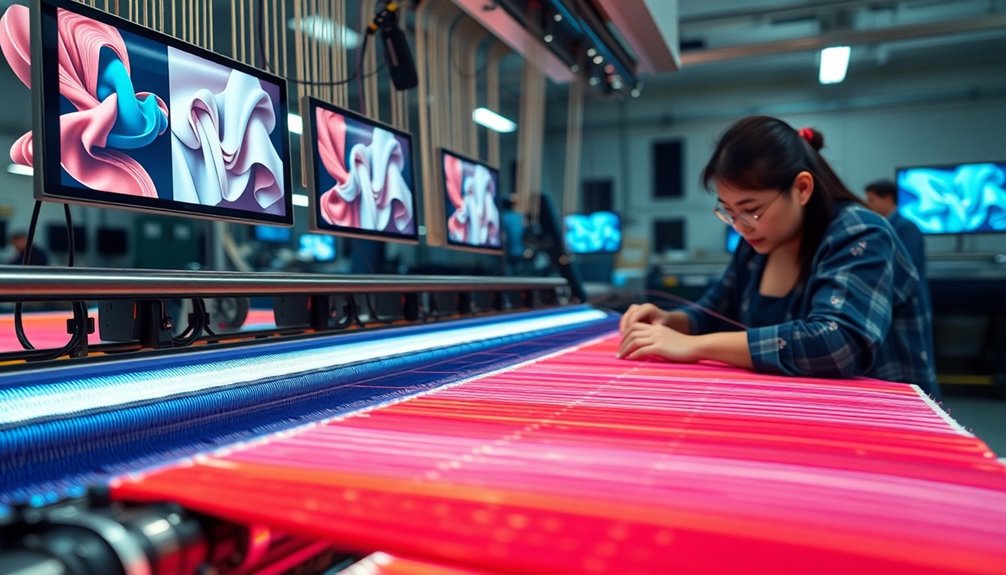
With sustainability driving changes in the textile industry, digital transformation is emerging as a powerful force that reshapes production processes.
You'll benefit from blockchain technology, which enhances supply chain transparency, ensuring ethical practices. Enhanced Transparency with Blockchain enables consumers to trace the garment journey from cotton farming to production.
IoT and smart machinery collect real-time data, optimizing equipment efficiency and predicting maintenance needs.
Artificial intelligence improves demand forecasting, reducing overproduction and waste.
Digital printing allows for rapid, precise design replication while minimizing costs and environmental impact.
3D design and prototyping speed up development by cutting the need for physical samples.
Furthermore, automation and data analytics streamline operations, enabling you to adapt quickly to consumer preferences.
Embracing these innovations not only boosts efficiency but also aligns with your commitment to sustainability.
Global Supply Chains and Market Dynamics
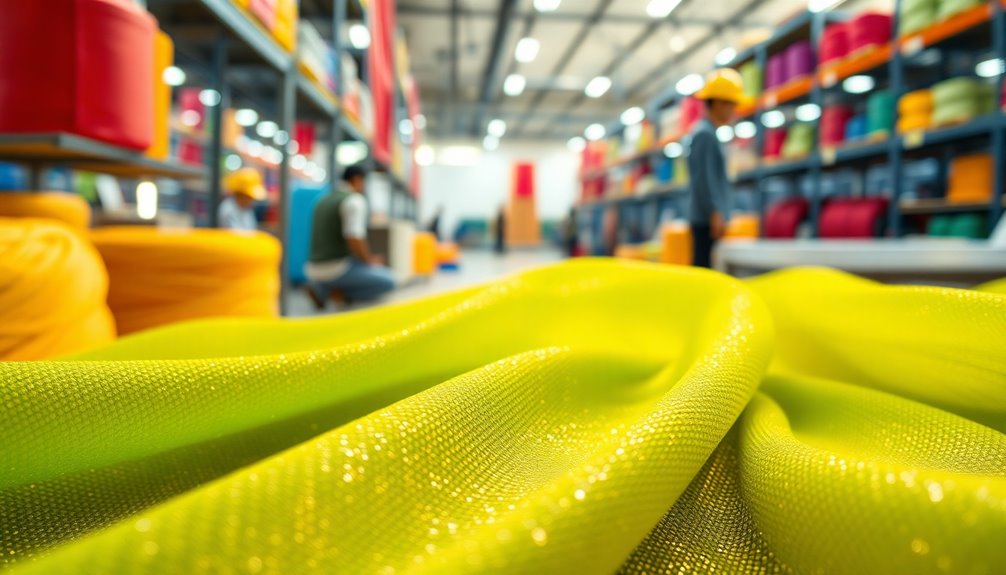
Steering through the complexities of global supply chains is essential for success in the textile industry, especially as market dynamics shift rapidly. The global supply chain management market in textiles is set to reach USD 5,394.62 million by 2031, growing at a remarkable CAGR of 9.71%. Key drivers like digital technologies and automation enhance your decision-making and operational efficiency. As the digital textile printing market continues to expand, it further emphasizes the need for agile supply chain strategies to meet evolving consumer preferences. Incorporating solar energy solutions into production processes can lead to significant cost reductions and sustainability improvements. Asia Pacific dominates due to its large-scale production capabilities, while North America pushes for sustainability. Globalization and e-commerce add complexity, demanding advanced solutions for visibility. As you navigate these trends, remember that consumer demands for transparency and ethical sourcing are reshaping your strategies, making adaptability vital in this ever-evolving landscape.
Challenges and Opportunities Ahead
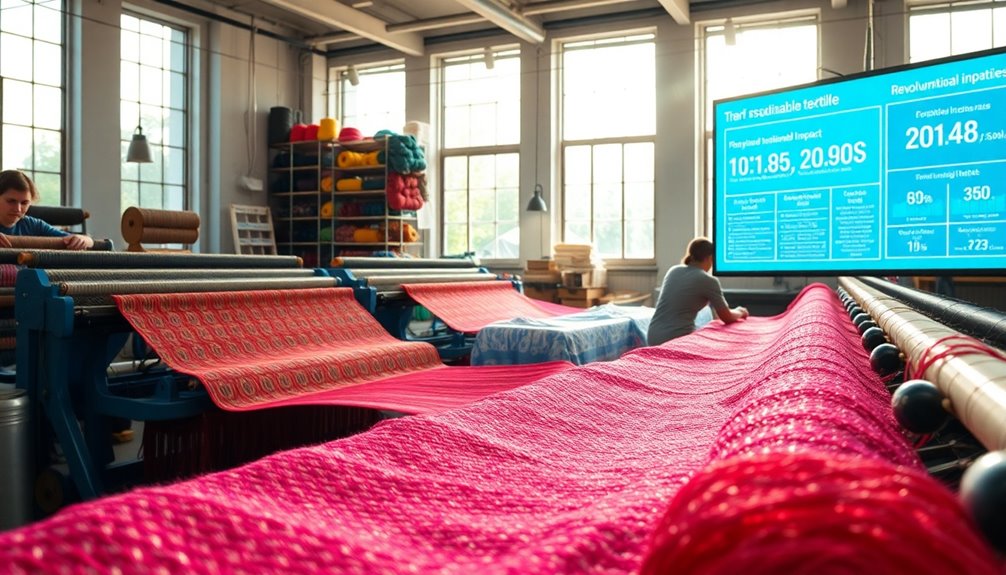
Steering through the textile industry today presents both significant challenges and promising opportunities that demand your attention.
Rising inflation impacts your profit margins, while stricter environmental regulations push you toward sustainable practices. Additionally, increasing labor costs in developing countries and outdated machinery hinder your competitiveness. However, the global apparel market is projected to reach ($1.9 trillion) by 2025, indicating a substantial opportunity for growth. The increasing consumer demand for sustainable products necessitates a shift in traditional manufacturing approaches.
Yet, amidst these challenges lie opportunities for innovation. Sustainable manufacturing technologies and bio-based materials are gaining traction, allowing you to reduce your carbon footprint. The demand for smart textiles and customization opens new avenues for differentiation.
Embracing digital transformation can enhance your operational efficiency, and the rise of e-commerce expands your market reach. With online sales of tea products increasing, particularly post-pandemic, similar strategies can be adapted for the textile industry to capture emerging consumer trends.
Frequently Asked Questions
What Are the Origins of Proto-Textile Practices in Different Cultures?
The origins of proto-textile practices span various cultures, showcasing diverse materials and techniques. In ancient civilizations, you'll find early materials like furs and leaves used for protection.
The invention of looms allowed for intricate weaving, with regions like Egypt specializing in linen and China in silk.
In the Americas, techniques like backstrap looming emerged, while Europe and Africa saw innovations in wool and flax.
These practices shaped cultural identities and trade routes across the globe.
How Did Proto-Industrialization Influence Social Structures in Textile-Producing Regions?
Proto-industrialization greatly reshaped social structures in textile-producing regions. You'd notice the rise of new classes, like entrepreneurs and wage laborers, as rural manufacturing expanded.
This shift led to increased income diversification for peasants, who balanced agriculture with textile production. Urban merchants began interacting more with rural producers, altering traditional roles.
As a result, the labor market transformed, emphasizing wage labor and changing the dynamics of agrarian societies. These changes laid the groundwork for future economic development.
What Role Did Gender Play in Proto-Industrial Textile Production?
Imagine a bustling medieval workshop, where skilled women weave intricate patterns while men oversee production.
In proto-industrial textile production, gender roles shaped the fabric of society. Women spun, wove, and embroidered, developing specialized skills that elevated their status and provided economic independence.
As they crafted textiles imbued with cultural meanings, they not only contributed to household economies but also forged identities, transforming social structures and creating pathways for future generations of women.
How Did Proto-Industrialization Affect Rural Economies and Communities?
Proto-industrialization transformed rural economies and communities by providing additional income sources beyond agriculture.
You noticed that families became more integrated into national and international markets, enhancing economic opportunities.
However, it also led to labor exploitation, as merchants exploited cheap rural workers.
This shift blurred traditional gender roles, with women and children contributing to production, while changing marriage and fertility patterns reflected the economic pressures of the time.
What Lessons Can Modern Textile Producers Learn From Proto-Industrial Practices?
Imagine a weaver in a quaint village, spinning threads that connect communities.
Modern textile producers can learn from proto-industrial practices by embracing decentralized production and flexibility.
Just like that weaver, you can harness local resources and innovative techniques to create sustainable fabrics.
Conclusion
So, as Proto Textile sweeps through the fabric industry like a trend-hopping influencer, you can either embrace the revolution or cling to your old cotton tees. Sure, innovation and sustainability sound great, but who needs a guilt-free conscience when you can have that vintage vibe? Let's just hope your wardrobe can keep up with these changes, because at this rate, soon even your grandma's quilt might get a tech upgrade. Welcome to the future of fabric, folks!
